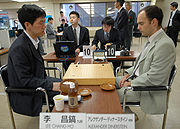 Go (game)
Go (game)  Go professional
Go professional
Go professional
For much of the 20th century, Go continued to be dominated by players trained in Japan. Notable names included Eio Sakata, Rin Kaiho (born Lin Haifeng in Taiwan), Masao Kato, Koichi Kobayashi and Cho Chikun (born Cho Ch'i-hun, South Korea). Top Chinese and Korean talents often moved to Japan, because the level of play there was high and funding was more lavish. One of the first Korean players to do so was Cho Namchul, who studied in the Kitani Dojo 1937?1944. After his return to Korea, the Hanguk Kiwon (Korean Go Association) was formed and caused the level of play in South Korea to rise significantly in the second half of the 20th century.[59] In China, the game declined during the Cultural Revolution (1966?1976) but quickly recovered in the last quarter of the 20th century, bringing Chinese players, such as Nie Weiping and Ma Xiaochun, on par with their Japanese and Korean counterparts.

Korean player Lee Chang-ho, considered by many to be the best player of the late 20th and early 21st centuries, plays against Russian player Alexandre Dinerchtein, seven-time European Champion and one of the few Western players to reach professional status.
With the advent of major international titles from 1989 onward, it became possible to compare the level of players from different countries more accurately. Korean players such as Lee Chang-ho, Cho Hunhyun, Lee Sedol and Yoo Changhyuk dominated international Go and won an impressive number of titles.[61] Several Chinese players also rose to the top in international Go, most notably Ma Xiaochun, Chang Hao and Gu Li. As of 2008, Japan lags behind in the international Go scene.
Historically, as with most sports and games, more men than women have played Go. Special tournaments for women exist, but until recently, men and women did not compete together at the highest levels; however, the creation of new, open tournaments and the rise of strong female players, most notably Rui Naiwei, have in recent years highlighted the strength and competitiveness of emerging female players.
The level in other countries has traditionally been much lower, except for some players who had preparatory professional training in Asia. Knowledge of the game has been scant elsewhere up until the 20th century. A famous player of the 1920s was Edward Lasker. It was not until the 1950s that more than a few Western players took up the game as other than a passing interest. In 1978, Manfred Wimmer became the first Westerner to receive a professional player's certificate from an Asian professional Go association. In 2000, a Westerner, Michael Redmond, finally achieved the top rank awarded by an Asian Go association, 9 dan. In total, as of 2008, only nine non-Asian Go players have ever achieved professional status in Asian associations.
